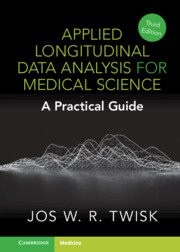Book contents
- Applied Longitudinal Data Analysis for Medical Science
- Applied Longitudinal Data Analysis for Medical Science
- Copyright page
- Dedication
- Content
- Preface
- Acknowledgements
- Chapter 1 Introduction
- Chapter 2 Continuous Outcome Variables
- Chapter 3 Continuous Outcome Variables: Regression-based Methods
- Chapter 4 The Modelling of Time
- Chapter 5 Models to Disentangle the Between- and Within-subjects Relationship
- Chapter 6 Causality in Observational Longitudinal Studies
- Chapter 7 Dichotomous Outcome Variables
- Chapter 8 Categorical and Count Outcome Variables
- Chapter 9 Outcome Variables with Floor or Ceiling Effects
- Chapter 10 Analysis of Longitudinal Intervention Studies
- Chapter 11 Missing Data in Longitudinal Studies
- Chapter 12 Sample Size Calculations
- Chapter 13 Software for Longitudinal Data Analysis
- References
- Index
Chapter 3 - Continuous Outcome Variables: Regression-based Methods
Published online by Cambridge University Press: 20 April 2023
- Applied Longitudinal Data Analysis for Medical Science
- Applied Longitudinal Data Analysis for Medical Science
- Copyright page
- Dedication
- Content
- Preface
- Acknowledgements
- Chapter 1 Introduction
- Chapter 2 Continuous Outcome Variables
- Chapter 3 Continuous Outcome Variables: Regression-based Methods
- Chapter 4 The Modelling of Time
- Chapter 5 Models to Disentangle the Between- and Within-subjects Relationship
- Chapter 6 Causality in Observational Longitudinal Studies
- Chapter 7 Dichotomous Outcome Variables
- Chapter 8 Categorical and Count Outcome Variables
- Chapter 9 Outcome Variables with Floor or Ceiling Effects
- Chapter 10 Analysis of Longitudinal Intervention Studies
- Chapter 11 Missing Data in Longitudinal Studies
- Chapter 12 Sample Size Calculations
- Chapter 13 Software for Longitudinal Data Analysis
- References
- Index
Summary
In Chapter 3, regression-based methods to analyse longitudinal data are introduced. Linear mixed models analysis and linear GEE mixed model analysis are explained in detail, while the adjustment for covariance method is explained in less detail. It is shown that the different regression-based methods adjust for the correlated observations within the subject in a different way; linear mixed model analysis by allowing different regression coefficients for different subjects (i.e. random intercept and random slope(s)), GEE analysis by estimating directly the correlation between the repeated observations within the subject by assuming a priori a certain correlation structure. It is explained that a linear mixed model analysis with only a random intercept is basically the same as a linear GEE analysis with an exchangeable correlation structure. In this chapter, special attention is given to the interpretation of the regression coefficient, which is a weighted average of the between-subjects relationship and the within-subjects relationship. All methods are accompanied by extensive real-life data examples.
Keywords
- Type
- Chapter
- Information
- Applied Longitudinal Data Analysis for Medical ScienceA Practical Guide, pp. 31 - 55Publisher: Cambridge University PressPrint publication year: 2023

